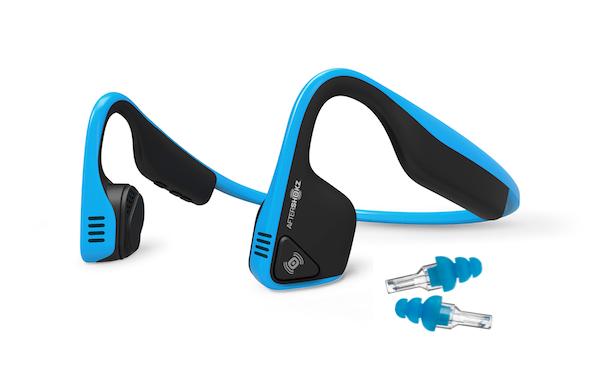Hearing the Signal Through the Noise with AfterShokz and Etymotic

Let’s take this real-world (well, as "real” as my world gets) example. I have a pair of Ultimate Ears Pro Custom In-Ear Reference Monitors made specifically to fit my ears thanks to custom impressions taken by an audiologist. The in-ear monitors sell for $999—not including the cost of the audiologist—so you can bet they’re no slouch when it comes to audio quality, comfort, and sound isolation. I keep them in my briefcase to use whenever I’m “working” away from my desk.
I regularly mow about four acres of grass during the spring and summer months, and a lot of that mowing is done under apple and cedar trees with low-hanging branches. After countless times of having an earbud yanked out of one or both ears after the cord caught on a branch, I realized that tree branches have an irresistible attraction to headphone cords—regardless of how or where you try to hide them. I’ve snapped the cords on way too many pairs of earbuds thanks to the trees, and I’ve mowed over at least one set. You might think that using cheap earbuds when mowing is the obvious solution to the problem. That’s true, but cheap (and even not-so-cheap) earbuds are typically uncomfortable, quickly cause listener fatigue (i.e., they sound like crap), and are absolutely horrible at sound isolation.
My riding mower is loud. At the seat, the SPL of the running engine measures between 88 and 96 dB. That’s in the range between the noise of a diesel truck 10 meters away and the sound pressure level you’d experience standing one meter away from a loudspeaker in a disco. Although the so-called “threshold of discomfort” begins at 120 dB, I don’t find it comfortable having my ears acoustically assaulted as if I were 30 feet from a big rig at a truck stop for hours at a time. Out of desperation, I began wearing safety ear muffs over the ear buds. I didn’t improve the sound quality, but it definitely cut down on the noise.
Of course, wearing ear muffs over earbuds brings many of the drawbacks associated with over-the-ear headphones (heavy, uncomfortable to wear for long periods of time, and they make my ears sweat) with the worst aspects of cheap earbuds (namely, poor sound quality and discomfort). Unfortunately, tree branches are drawn to ear muff headbands about as much as they love headphone cords.
For obvious reasons, despite the fact that the Ultimate Ears Pro Custom In-Ear Monitors have excellent noise isolation and a sturdy, thick cord, they’re the last thing I’d use in this headphone-destruction zone.
Over the eight years I’ve lived here, I’ve researched alternatives to the cheap-headphone and uncomfortable-ear-muff combo, ranging from active noise-cancelling headphones, ear muffs with built-in FM or Bluetooth, ear plugs (with no headphones), and noise-cancelling, electronic ear muffs. For me, the best solution to the noise problem was a set of ETY Plugs High Fidelity Earplugs from Etymotic. The ETY Plugs are awesome in many ways:
- They reduce sound approximately 20 dB at all frequencies so, for example, speech is not muffled as it is with other hearing protectors.
- They’re reusable (Etymotic says to replace them every 3-6 months, but this will be the third summer using the set I have. Based on their condition, though, this will probably be their last fling in the sunshine.)
- At $12.95 for a pair including a carrying case, they’re cheap.
- They’re comfortable enough that I sleep with them in my ears when staying at noisy hotels, so wearing them for a couple hours of mowing is nothing.
Bingo! No more uncomfortable, sweaty, tree-interfering ear muffs. But my goal wasn’t to spend my quality mowing time listening to a noisy combustion engine, albeit now at a tolerable 68-76 dB. I want to use that time to listen to podcasts, damnit!
Now’s when the AfterShokz’s Wireless Trekz Titanium Bone Conduction Headphones make their appearance in this story. It turns out that bone-conduction headphones and Etymotic’s ETY Plugs are quite compatible with one another. In fact, if anything, having the ETY Plugs in your ears improves the sound quality of the Trekz Titanium headphones because the ETY Plugs block the sound that fuzzy sound that “leaks” out of the outer side of the Trekz Titanium headphones. The perceived volume level is reduced but podcasts, for example, benefit from increased intelligibility. What’s more, the trees haven’t quite figured out that the AfterShokz Trekz Titanium are actually headphones, so I haven’t had a branch snag them off my head, yet. (Knock on wood…)
So which is the better product—the $999 Ultimate Ears Pro Custom In-Ear Reference Monitors or the Etymotic ETY Plugs combined with the AfterShokz Trekz Titanium bone conduction headphones? It’s impossible to answer that question without a good understanding of the intended end usage. Bone conduction certainly isn’t the best method to use for high fidelity, but expensive reference earbuds with custom impressions are an equally awful choice for getting get listenable audio on a riding mower.
This is one of those few cases in which the ends do justify the means—and a good example of why it’s so difficult to say one product is unequivocally better than another one.
It’s now officially okay to feel sorry for all the people like us who have to test new gear all the time as part of our jobs. It’s a bitch, but somebody’s got to do it…













































